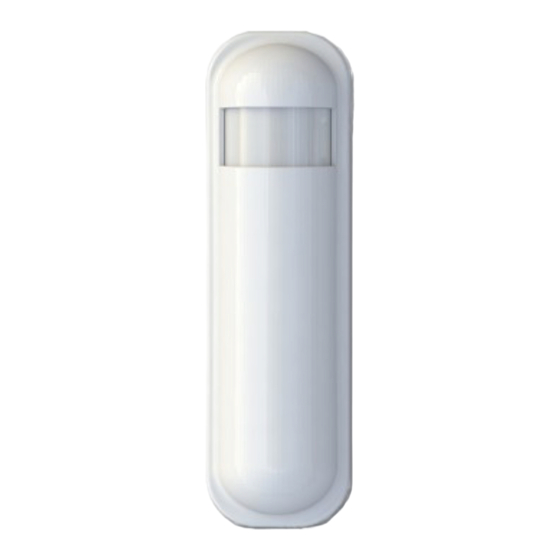
Table of Contents
Advertisement
Quick Links
Slim Multi-Sensor PSP01
The slim multi-sensor PSP01 has PIR, temperature and illumination, 3
sensors function in one, based on Z-Wave
wireless communication protocol designed for home automation,
specifically to remotely control applications in residential and light
commercial environments. The technology uses a low-power RF radio
embedded or retrofitted into home electronics devices and systems,
such as lighting, home access control, entertainment systems and
household appliances.
This device is one component of the Z-Wave
designed to work with all other Z-Wave
control network. The device adopt the Z-Wave
your Z-Wave
TM
network system is all made by Z-Wave
devices. The network system will have the advantages as below.
Concurrent multi-channel support reduces external interference.
•
Better RF range, improve about 10 meters in indoor.
•
Support 100 Kbps transmit speed, speed up communication.
•
TM
technology. Z-Wave
TM
is a
TM
sensor system and is
TM
enabled devices in a home
TM
400 series chip, when
TM
400 series
Adding to Z-Wave
TM
There are two tamper keys in the device, one is in the back side,
another is in the front side. They have the same function. Both of them
can inclusion, exclusion, reset or association from Z-Wave
In the first time, add the device into the Z-Wave
sure the primary controller is in the inclusion mode. And then power on
the device, just take out the insulation Mylar in the back side of the
device. The device will auto start the NWI (Network Wide Inclusion)
mode. And it should be included in 5 seconds. You will see the LED
light ON one second.
Function
Description
1. Have Z-Wave
2. Pressing tamper key three times within 1.5 seconds
will enter inclusion mode.
Inclusion
3. After inclusion successful, the device will wake to
receive the setting command from Z-Wave
Controller about 20 seconds.
1. Have Z-Wave
2. Pressing tamper key three times within 1.5 seconds
Exclusion
will enter exclusion mode.
Node ID has been excluded.
1. Pressing tamper key four times within 1.5 seconds
and do not release the tamper key in the 4
pressed, and the LED will turn ON.
2. After 3 seconds the LED will turn OFF, after that
within 2 seconds, release the tamper key. If
Reset
successful, the LED will light ON one second.
Otherwise, the LED will flash once.
3. IDs are excluded and all settings will reset to
factory default.
1
Network
TM
network. First, make
TM
Controller entered inclusion mode.
TM
Controller entered exclusion mode.
TM
network.
TM
th
Advertisement
Table of Contents

Summary of Contents for Philio PSP01
- Page 1 ON one second. Function Description 1. Have Z-Wave Controller entered inclusion mode. The slim multi-sensor PSP01 has PIR, temperature and illumination, 3 2. Pressing tamper key three times within 1.5 seconds sensors function in one, based on Z-Wave technology. Z-Wave is a will enter inclusion mode.
- Page 2 Z-Wave Message Report 1. Have Z-Wave Controller entered association mode. * Motion Report: 2. Pressing tamper key three times within 1.5 seconds When the PIR motion detected, the device will unsolicited to send the will enter association mode. Association Note: The device support 2 groups. The group 1 is for “Sensor Binary Report”...
-
Page 3: Power Up Procedure
“Sensor Multilevel Report” to the nodes in the group 1. Sensor Type: Luminance (0x03) * Wake Note: To disable this functionality by setting the configuration setting When the power on, the device will wake about 20 seconds. In this N0.5, the bit4 of the value to 1. duration, the controller can communicate with the device. - Page 4 When the event triggered, the device will report the messages to the nodes in the group 1. The messages also include the temperature and the illumination level. The user can switch the report by configuration setting NO. 5. Caution: In the “Home Automation Mode” if the environment luminance higher than the setting, the device won't report the message.
-
Page 6: Battery Installation
Battery Installation When the device report the low battery message. The user should replace the battery to new one. The way to open the front cover please follow below steps. 1. Using a tool like (1) to press 1-1 till hear a click sound 2. -
Page 7: Installation
Installation After finish the test and decide to fix, then you can remove tape A, and mounting the sensor by using tape B. This will close the tamper key 1. In the first time, add the device into the Z-Wave network. - Page 8 1 to 100 means the light strength. Bit2: Reserved, always 1. Bit3: Setting the temperature scale. PIR sensitivity settings. 0: Fahrenheit , 1: Celsius 0 means disable the PIR motion. Bit4: Disable illumination report after 1 means the lowest sensitivity, event triggered.
-
Page 9: Specifications
PIR not detecting. Specifications After turn on the light, setting the delay Power by CR123A lithium battery. time to turn off the light when the PIR Signal (Frequency): Turn Off Light 4~127 motion is not detected. 8 seconds per 868.42 MHz(EU), Time tick, and minimum time is 32 seconds, 908.42 MHz(US),... -
Page 10: Fcc Interference Statement
FCC Interference Statement Warning This equipment has been tested and found to comply with the limits for Do not dispose of electrical appliances as unsorted municipal waste, a Class B digital device, pursuant to Part 15 of the FCC Rules. These use separate collection facilities.
















Need help?
Do you have a question about the PSP01 and is the answer not in the manual?
Questions and answers